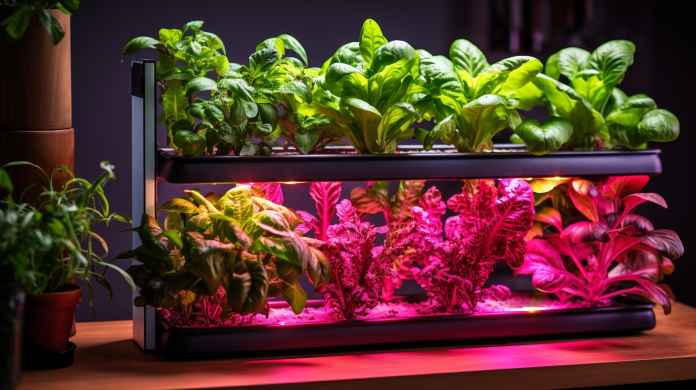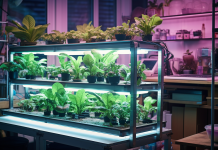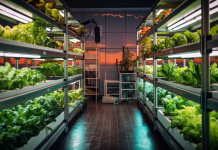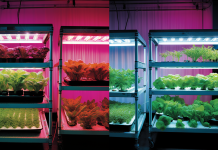In the realm of hydroponic cultivation, optimizing growth through advanced lighting techniques in hydroponics is a key area of focus.
The Importance of Light Intensity in Hydroponic Systems
Light intensity, the measure of light energy received by plants, plays a pivotal role in hydroponic systems where plants rely on nutrient-rich water solutions. Light is the primary energy source for plants, driving photosynthesis and, consequently, plant growth.
Insufficient light intensity can result in weak and stunted plants, while excessive light intensity can induce stress and damage. Striking the right balance is essential for robust hydroponic growth and higher yields.
Understanding the Role of Light Spectrum in Plant Growth
The light spectrum, defined by various wavelengths emitted by light sources, affects different aspects of plant growth and development. For instance, red light promotes flowering and fruiting, while blue light stimulates vegetative growth and leaf development.
By manipulating the light spectrum, hydroponic growers can tailor lighting systems to meet the specific needs of plants at different growth stages, enhancing overall crop quality and yield.
Exploring the Benefits of LED Lighting for Hydroponic Cultivation
LED lighting offers several advantages for hydroponic cultivation. LEDs are energy-efficient, consuming less power and reducing operational costs. Additionally, LEDs allow precise control over the light spectrum, optimizing photosynthesis and crop quality. Their extended lifespan reduces maintenance, ensuring consistent and reliable lighting.
Enhancing Photosynthesis Efficiency With Advanced Lighting Techniques
Advanced lighting techniques maximize photosynthesis efficiency, essential for healthy plant growth. Full spectrum LED lights provide balanced wavelengths required for chlorophyll synthesis and other vital plant processes. Adjustable LED intensities enable customization, ensuring ideal light levels during different growth stages. These techniques collectively promote healthier and more productive hydroponic crops.
Optimizing Light Duration and Photoperiod for Maximum Growth
Fine-tuning light duration and photoperiod are crucial for achieving maximum plant growth. Factors like light intensity and duration affect plant development, making it essential to find the right balance. Manipulating the photoperiod can influence flowering, fruiting, and other physiological processes.
In hydroponics, photoperiod refers to the specific duration and timing of artificial light exposure provided to plants grown without soil, which is carefully controlled to optimize growth and reproduction.
The Impact of Light Distribution and Positioning on Crop Yield and Quality
Strategic light distribution and positioning are vital for achieving maximum crop yield and quality in hydroponic systems. Proper distribution minimizes shading, ensuring uniform growth and preventing yield variations. Careful positioning impacts factors such as plant morphology, leaf coloration, and nutrient uptake, ultimately influencing crop quality.
Plant morphology refers to the physical structure and characteristics of a plant, encompassing features like its size, shape, branching pattern, and overall appearance.
Leaf coloration pertains to the hue and pigmentation of a plant's leaves, which can vary based on factors like chlorophyll content, nutrient levels, and environmental conditions.
Nutrient uptake involves the process by which plants absorb essential elements and compounds from their surrounding environment, such as soil or hydroponic nutrient solutions, to support their growth and development.
Ultimately, these factors collectively influence crop quality by determining the health, size, and appearance of the harvested plants or produce.
Key Takeaways
- Full spectrum LED lights enhance chlorophyll synthesis and essential plant processes.
- Adjustable LED intensities allow customization for different growth stages.
- Advanced lighting techniques maximize photosynthetic efficiency.
- Careful adjustment of light duration and photoperiod maximizes plant growth.
| Advanced Lighting Techniques | Benefits |
| Full spectrum LED lights | – Provides balanced light spectrum |
| Enhances chlorophyll synthesis | |
| Supports essential plant processes | |
| Adjustable LED intensities | – Customizable light levels |
| Optimal for different growth stages | |
| Maximizes plant growth and productivity |
Conclusion
In conclusion, optimizing lighting techniques in hydroponic systems is crucial for maximizing plant growth and yield. Light intensity, spectrum, duration, and distribution all play important roles in enhancing photosynthesis efficiency and overall crop quality.
LED lighting has proven to be beneficial in providing the optimal light spectrum for plant growth. By understanding and implementing advanced lighting techniques, hydroponic cultivators can achieve optimal results and improve the efficiency and productivity of their systems.
Please see our supporting article:
Hydroponic Lighting Options Compared



